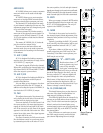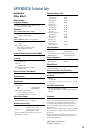
17
40. AUX 2/EFX RETURN FADER, MUTE
The EMAC output is added to any signals
going into the AUX 2 RETURN (10) jacks from
an external effects processor. The final effects
signal is then sent to this MUTE switch and
stereo fader. It acts like a channel fader, ex-
cept it is adding the final effects signal to the
main mix, rather than adding a channel signal.
Turned fully up, it provides 10 dB of gain,
“U” is unity gain, and fully down is off.
Press MUTE to quickly compare the differ-
ence between adding, or not adding effects.
The MUTE and fader affect the level of the
effects going to the main mix only, and not of
any effects going to the monitors.
41. AUX 1/MON SEND
This allows you to control the level of the
signal going out to your monitors.
Any signals from each channel’s AUX 1/MON
(21) control (and the EFFECTS TO MONITOR
(42) control), are summed together, then sent
through this master control.
Turned fully up, it provides 6 dB of gain,
“U” is unity gain, and fully down is off.
When the talent wants a louder monitor
mix, this is the control to crank up — watch
out for feedback!
42. EFFECTS TO MONITOR
Typically, this control is used to add effects to
the stage monitors. Any effects sent to the moni-
tors are the same as in the main mix, except
for the level, and they are summed mono. The
effects level sent to the monitor mix is not af-
fected by the AUX 2/EFX RETURN (40) fader,
so the monitors and main mix effect levels can
be set independently.
Turned fully up, this control provides 6 dB
of gain, and “U” is unity gain. Turn it fully
down for no effects sent to your monitors.
This control is similar to each channel’s
AUX 1/MON (21) control, except it adds the ef-
fects (summed mono) to the monitor mix,
rather than adding a channel signal.
43. AUX 1 RETURN FADER and MUTE
Any signals going into the AUX 1 RETURN
(9) jacks from an external processor pass
through the MUTE switch and then to this ste-
reo fader. This is like a channel fader, except it
is adding the signal from an external device to
the main mix, rather than adding a channel
signal. Turned fully up, it provides 10 dB of
gain, “U” is unity gain, and fully down is off.
EMAC EFFECTS PROCESSOR
EMAC stands for Extended Multiply and Ac-
cumulate, which is a proprietary 32-bit digital
stereo processor developed by our Digital En-
gineering Group. It provides you with a choice
of 16 preset digital effects algorithms for your
enjoyment.
The mono signal going into the EMAC
comes from the AUX 2/EFX (22) controls of
each channel, summed together and passed
through the AUX 2/EFX SEND (38) control.
Note that the AUX 2/EFX signals are post-
channel EQ and post-channel fader, so any
channel adjustments will alter the effects.
The EMAC takes the mono input, processes
it and creates a stereo output. A footswitch al-
lows the EMAC to be bypassed and a SET
LEVEL LED (39) allows the input signal
strength to be optimized for best performance.
The processed stereo signals coming out of
the EMAC are added to any signals coming in
from an external processor connected to the
AUX 2 RETURN (10) jacks. The combined sig-
nals then pass through the MUTE (40) and
AUX 2/EFX RETURN (40) fader and then on
to the main mix.
EMAC QUICK START
Assuming you have your basic mix up and
running, turn up the AUX 2 /EFX (22) controls
on each channel. This feeds individual
amounts of channel signals to the EMAC.
Set the master AUX 2 /EFX SEND (38) con-
trol so the EMAC’s LEVEL SET LED (39)
blinks occasionally.
Turn up the AUX 2/EFX (40) fader and you
should be hearing the effects.
Next, goof around with the various Preset
Selects (45) to listen to their effect. When you
find an effect you like, jot it down, then goof
around some more.
To bypass these effects, engage an optional
foot switch connected to EFX FOOT SWITCH
(13). To send these effects to the stage moni-
tors, turn up the EFFECTS TO MONITOR (42)
knob.
44. BYPASS LED
This LED will come on when the EMAC cir-
cuit is bypassed by use of an external
footswitch. The bypass affects only the internal
EMAC effects, not any external effects proces-
sor you may have connected to the AUX 2
RETURN (10) jacks.


















